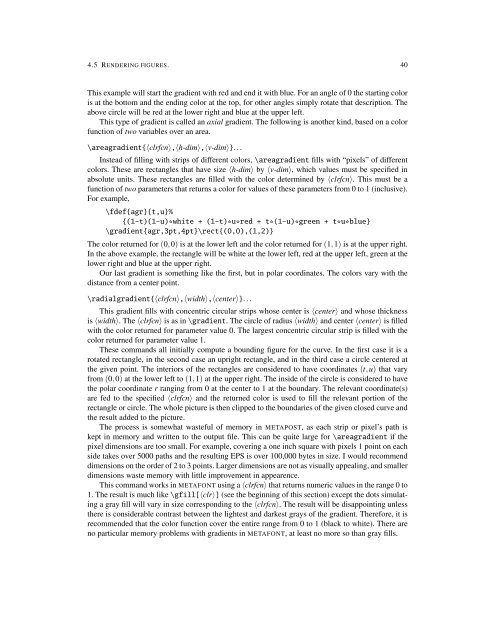You also want an ePaper? Increase the reach of your titles
YUMPU automatically turns print PDFs into web optimized ePapers that Google loves.
4.5 RENDERING FIGURES. 40<br />
This example will start the gradient with red and end it with blue. For an angle of 0 the starting color<br />
is at the bottom and the ending color at the top, for other angles simply rotate that description. The<br />
above circle will be red at the lower right and blue at the upper left.<br />
This type of gradient is called an axial gradient. The following is another kind, based on a color<br />
function of two variables over an area.<br />
\areagradient{〈clrfcn〉,〈h-dim〉,〈v-dim〉}...<br />
Instead of filling with strips of different colors, \areagradient fills with “pixels” of different<br />
colors. These are rectangles that have size 〈h-dim〉 by 〈v-dim〉, which values must be specified in<br />
absolute units. These rectangles are filled with the color determined by 〈clrfcn〉. This must be a<br />
function of two parameters that returns a color for values of these parameters from 0 to 1 (inclusive).<br />
For example,<br />
\fdef{agr}{t,u}%<br />
{(1-t)(1-u)*white + (1-t)*u*red + t*(1-u)*green + t*u*blue}<br />
\gradient{agr,3pt,4pt}\rect{(0,0),(1,2)}<br />
The color returned for (0,0) is at the lower left and the color returned for (1,1) is at the upper right.<br />
In the above example, the rectangle will be white at the lower left, red at the upper left, green at the<br />
lower right and blue at the upper right.<br />
Our last gradient is something like the first, but in polar coordinates. The colors vary with the<br />
distance from a center point.<br />
\radialgradient{〈clrfcn〉,〈width〉,〈center〉}...<br />
This gradient fills with concentric circular strips whose center is 〈center〉 and whose thickness<br />
is 〈width〉. The 〈clrfcn〉 is as in \gradient. The circle of radius 〈width〉 and center 〈center〉 is filled<br />
with the color returned for parameter value 0. The largest concentric circular strip is filled with the<br />
color returned for parameter value 1.<br />
These commands all initially compute a bounding figure for the curve. In the first case it is a<br />
rotated rectangle, in the second case an upright rectangle, and in the third case a circle centered at<br />
the given point. The interiors of the rectangles are considered to have coordinates (t,u) that vary<br />
from (0,0) at the lower left to (1,1) at the upper right. The inside of the circle is considered to have<br />
the polar coordinate r ranging from 0 at the center to 1 at the boundary. The relevant coordinate(s)<br />
are fed to the specified 〈clrfcn〉 and the returned color is used to fill the relevant portion of the<br />
rectangle or circle. The whole picture is then clipped to the boundaries of the given closed curve and<br />
the result added to the picture.<br />
The process is somewhat wasteful of memory in METAPOST, as each strip or pixel’s path is<br />
kept in memory and written to the output file. This can be quite large for \areagradient if the<br />
pixel dimensions are too small. For example, covering a one inch square with pixels 1 point on each<br />
side takes over 5000 paths and the resulting EPS is over 100,000 bytes in size. I would recommend<br />
dimensions on the order of 2 to 3 points. Larger dimensions are not as visually appealing, and smaller<br />
dimensions waste memory with little improvement in appearence.<br />
This command works in METAFONT using a 〈clrfcn〉 that returns numeric values in the range 0 to<br />
1. The result is much like \gfill[〈clr〉] (see the beginning of this section) except the dots simulating<br />
a gray fill will vary in size corresponding to the 〈clrfcn〉. The result will be disappointing unless<br />
there is considerable contrast between the lightest and darkest grays of the gradient. Therefore, it is<br />
recommended that the color function cover the entire range from 0 to 1 (black to white). There are<br />
no particular memory problems with gradients in METAFONT, at least no more so than gray fills.

















